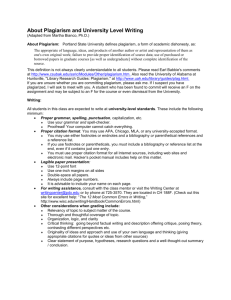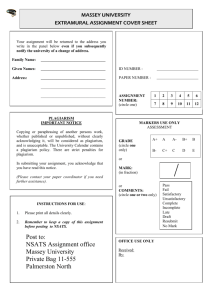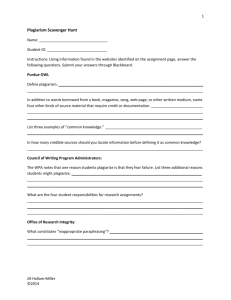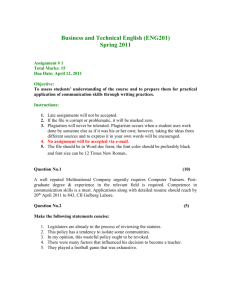Unquestionable Plagiarism
advertisement
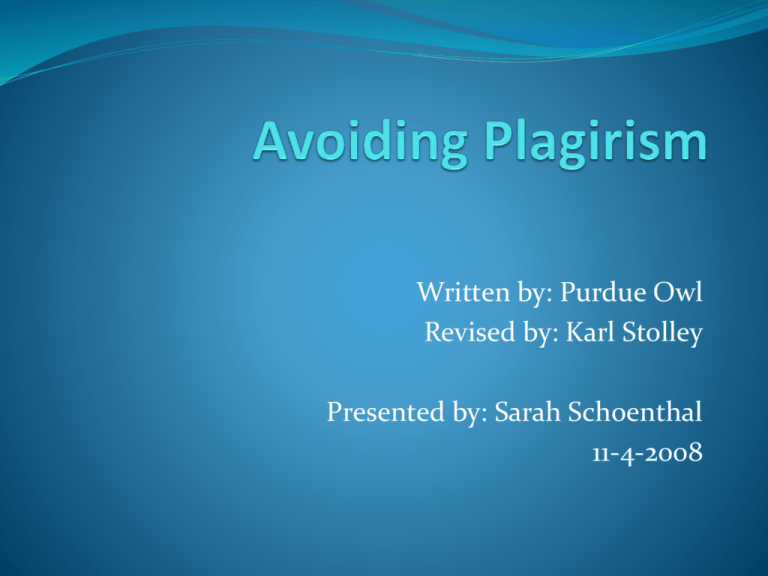
Written by: Purdue Owl Revised by: Karl Stolley Presented by: Sarah Schoenthal 11-4-2008 Overview What is plagiarism? Examples Practices to avoid plagiarism Useful Tips Consequences of Plagiarism Conclusion What is Plagiarism The uncredited use of somebody’s words or ideas whether it is intentional or unintentional. - Unquestionable Plagiarism - Gray Area What is Plagiarism cont’d Unquestionable Plagiarism: Buying, stealing, borrowing a paper, hiring someone to write your paper, copying sections of text without using “_” or citing the source. Gray Area: Paraphrasing- when using words of source too closely. Building off someone’s ideas. Examples Citation Needed vs. No Citation Citation Needed Words/ideas in magazine, book, newspaper, song, TV program, movie, webpage, computer program, letter, advertisement Information gained by interviewing or conversing with another person. Copying exact words Reprint diagrams, illustrations, charts, pictures Using electronic media like images, audio, video Figure: The Expanded Behavioral Model (Source: Aday, LA., Andersen, R., & Fleming, GV. Health Care in the US: Equitable for Whom? © 1980 Sage Publications, Inc.) Fig. Characteristics of Health Delivery System Availability Volume Distribution Organization Entry Structure Health Policy Financing Organization Characteristics of Population-at-risk Predisposing Mutable Immutable Enabling Mutable Immutable Need Perceived Evaluated Utilization of Health Services Consumer Satisfaction Type Site Purpose Time Interval Convenience Availability Financing Provider Characteristics Examples Citation Needed vs. No Citation No citation needed: When something is common knowledge Generally accepted facts If same information is found in at least 5 creditable sources If it’s something the reader will already know Own pictures, ideas, experiences, research Practices to Avoid Plagiarism Record relevant information (books, titles URLs) Mark own thoughts clearly when taking notes Use statements that credit source According to Kenley… If paraphrasing, try doing it without looking at original. Use “_” if reluctant to change a phrase Practices to Avoid Plagiarism Quote no more material than necessary To shorten quotes, remove information by using elipses. (…) if information omitted is in same sentence (….) if information omitted is between two sentences If adding own words, use [ ] but don’t editorialize or skew the original meaning Kozol claims there are “savage inequalities” in our educational system, which is obvious. Kozol claims there are “[obvious] savage inequalities” in our educational system. Useful Tips Use quotes that have the greatest impact Too many quotes diminish credibility Maintain drafts of papers Proofread and cross-check notes Double check citaiton and add bibliography, references or works cited page. Consequences of Plagiarism Expulsion form university Lose a job Loss of credibility More Information on UMBC’s plagiarism policy http://www.umbc.edu/provost/integrity/acc_policy/ Conclusion Key to avoid plagiarism is to give credit where credit is due. Most people don’t mean to plagiarize but mistakes still happen When in doubt, cite! Questions?? Reference “Avoiding Plagiarism.” The Owl at Purdue Sept. 30th 2008 <http://owl.english.purdue.edu/owl/resource/589/01/>



